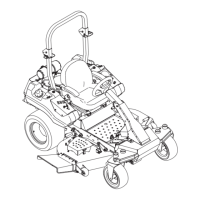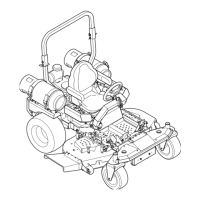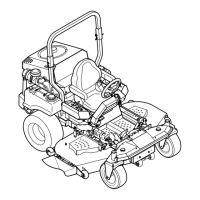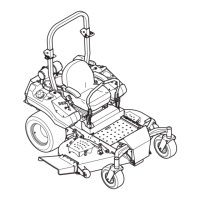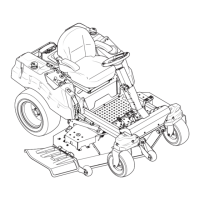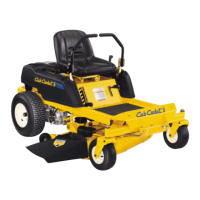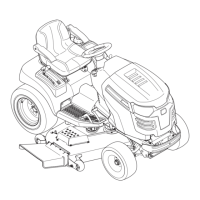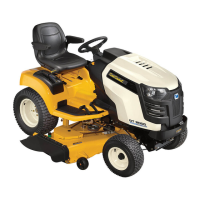Section 6 — Maintenance & adjuStMentS 29
Deck Wash System
WARNING! When using the deck wash system, never
engage the deck from any position other than the
operator’s seat of the tractor. Do not use an assistant or
engage deck in the presence of any bystanders.
Use the Deck Wash System to rinse grass clippings from the
deck’s underside and prevent the buildup of corrosive chemicals.
Complete the following steps after each mowing:
NOTE: Make certain the machine’s discharge chute is directed
away from people, children, animals, and your house, garage,
parked cars, etc.
1. Attach the nozzle adapter to a standard garden hose
connected to a water supply.
2. Move the tractor to an area within reach of the hose where you
won’t have a problem with wet grass clippings. Disengage the
PTO, engage the parking brake, and stop the engine.
3. Pull back the lock collar of the nozzle adapter and push the
adapter onto one of the deck wash nozzles at either end of
the mower deck. Release the lock collar to lock the adapter
on the nozzle. See Fig. 6-2.
Figure 6-2
4. Turn on the water supply.
5. From the tractor operator’s seat, start the engine and
engage the PTO. Allow to run as needed. Disengage the
PTO and stop the engine.
6. Turn off the water supply.
7. Pull back the lock collar of the nozzle adapter to disconnect
the adapter from the nozzle.
8. Repeat the previous steps to clean the deck using the
nozzle at the other end of the deck.
Tractor Storage
If your tractor is not going to be operated for an extended period
of time (thirty days to approximately six months), the tractor
should be prepared for storage. Store the tractor in a dry and
protected location. If stored outside, cover the tractor (including
the tires) to protect it from the elements. The procedures
outlined below should be performed whenever the tractor is
placed in storage.
1. Change the engine oil and filter following the instructions
provided in the engine manual.
WARNING! Never store the tractor with fuel in the
tank indoors or in poorly ventilated enclosures, where
fuel fumes may reach an open flame, spark or pilot
light as on a furnace, water heater, clothes dryer, etc.
2. If storing the tractor for 30 days or more:
a. To prevent gum deposits from forming inside
the engine’s carburetor and causing possible
malfunction of the engine, the fuel system must be
either completely emptied, or the gasoline must be
treated with a stabilizer to prevent deterioration.
WARNING! Fuel left in the fuel tank deteriorates
and will cause serious starting problems.
b. Using a fuel stabilizer:
• Read the product manufacturer’s instructions
and recommendations.
• Add to clean, fresh gasoline the correct
amount of stabilizer for the capacity
(approximately 3 gallons) of the fuel system.
• Fill the fuel tank with treated fuel and run the
engine for 2-3 minutes to get stabilized fuel
into the carburetor.
c. Emptying the fuel system:
• Prior to putting the tractor in storage, monitor
fuel consumption with the goal of running
the fuel tank empty.
• Close the fuel valve. Disconnect the fuel line
from the carburetor and put the end into an
approved fuel container.
• Open the fuel valve and drain the fuel tank
and line into the approved container. Reinstall
the fuel line on the carburetor.
• Start the engine and allow it to run out of fuel.
This will prevent gum and varnish deposits
from forming. Replace the fuel filter.
3. Remove the spark plugs and pour approximately one
ounce of oil into each cylinder. Crank the engine one or
two turns to spread the oil evenly on the cylinder walls.
Replace the spark plugs.
4. Clean the engine and the entire tractor thoroughly.
NOTE: Use of a pressure washer or garden hose is not
recommended to clean your tractor. This may cause
damage to electrical components, spindles, pulleys,
bearings or the engine. The use of water will result in
shortened life and reduce serviceability.
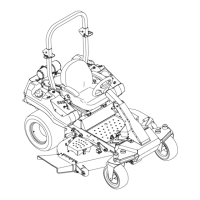
